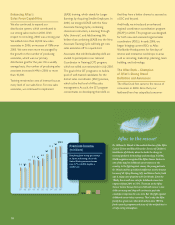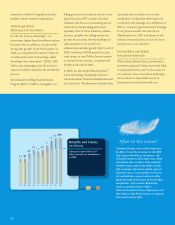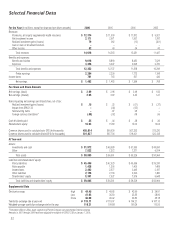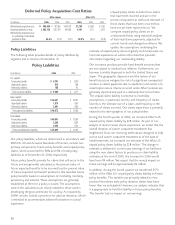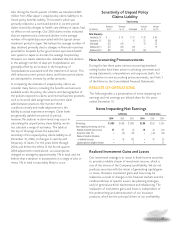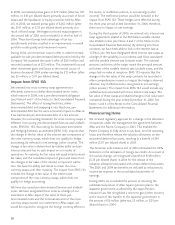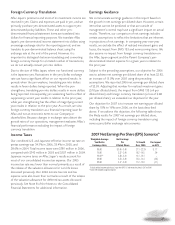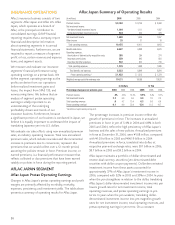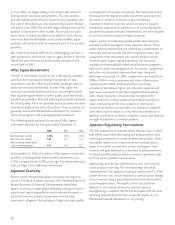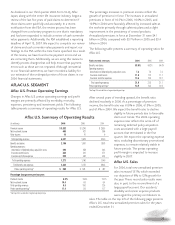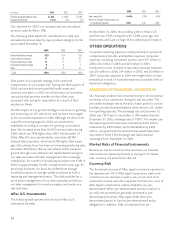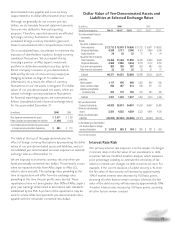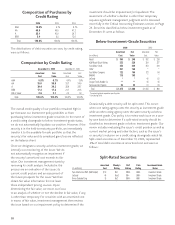Aflac 2006 Annual Report Download - page 32
Download and view the complete annual report
Please find page 32 of the 2006 Aflac annual report below. You can navigate through the pages in the report by either clicking on the pages listed below, or by using the keyword search tool below to find specific information within the annual report.
28
In 2006, we realized pretax gains of $79 million (after-tax, $51
million, or $.10 per diluted share) primarily as a result of bond
swaps and the liquidation of equity securities held by Aflac
U.S. In 2005, we realized pretax gains of $262 million (after-
tax, $167 million, or $.33 per diluted share) primarily as a
result of bond swaps. We began our bond-swap program in
the second half of 2005 and concluded it in the first half of
2006. These bond swaps took advantage of tax loss
carryforwards and also resulted in an improvement in overall
portfolio credit quality and investment income.
During 2004, we received an issuer’s offer to redeem certain
available-for-sale yen-denominated debt securities held by the
Company. We accepted the issuer’s offer of $205 million and
recorded a pretax loss of $23 million. This investment loss and
other investment gains and losses in the normal course of
business decreased 2004 pretax earnings by $12 million (after-
tax, $5 million, or $.01 per diluted share).
Impact from SFAS 133
We entered into cross-currency swap agreements to
effectively convert our dollar-denominated senior notes,
which mature in 2009, into a yen-denominated obligation
(see Notes 4 and 7 of the Notes to the Consolidated Financial
Statements). The effect of issuing fixed-rate, dollar-
denominated debt and swapping it into fixed-rate, yen-
denominated debt has the same economic impact on Aflac as
if we had issued yen-denominated debt of a like amount.
However, the accounting treatment for cross-currency swaps is
different from issuing yen-denominated Samurai and Uridashi
notes. SFAS No. 133, Accounting for Derivative Instruments
and Hedging Activities, as amended (SFAS 133), requires that
the change in the fair value of the interest rate component of
the cross-currency swaps, which does not qualify for hedge
accounting, be reflected in net earnings (other income). This
change in fair value is determined by relative dollar and yen
interest rates and has no cash impact on our results of
operations. At maturity, the fair value will equal initial contract
fair value, and the cumulative impact of gains and losses from
the changes in fair value of the interest component will be
zero. We have the ability and intent to retain the cross-
currency swaps until their maturity. The impact from SFAS 133
includes the change in fair value of the interest rate
component of the cross-currency swaps, which does not
qualify for hedge accounting.
We have also issued yen-denominated Samurai and Uridashi
notes. We have designated these notes as a hedge of our
investment in Aflac Japan. If the value of these yen-
denominated notes and the notional amounts of the cross-
currency swaps exceed our investment in Aflac Japan, we
would be required to recognize the foreign currency effect on
the excess, or ineffective portion, in net earnings (other
income). The ineffective portion would be included in the
impact from SFAS 133. These hedges were effective during
the three-year period ended December 31, 2006; therefore,
there was no impact on net earnings.
During the third quarter of 2006, we entered into interest rate
swap agreements related to the ¥20 billion variable interest
rate Uridashi notes (see Notes 4 and 7 of the Notes to the
Consolidated Financial Statements). By entering into these
contracts, we have been able to lock in the interest rate at
1.52% in yen. We have designated these interest rate swaps as
a hedge of the variability in our interest cash flows associated
with the variable interest rate Uridashi notes. The notional
amounts and terms of the swaps match the principal amount
and terms of the variable interest rate Uridashi notes, and the
swaps had no value at inception. SFAS 133 requires that the
change in the fair value of the swap contracts be recorded in
other comprehensive income so long as the hedge is deemed
effective. Any ineffectiveness is recognized in net earnings
(other income). The impact from SFAS 133 would include any
ineffectiveness associated with these interest rate swaps. The
fair value of these swaps and related changes in fair value were
immaterial during the year ended December 31, 2006. See
Notes 1 and 4 of the Notes to the Consolidated Financial
Statements for additional information.
Nonrecurring Items
We received regulatory approval for a change in the allocation
of expenses under the management fee agreement between
Aflac and the Parent Company in 2005. This enabled the
Parent Company to fully utilize its tax-basis, non-life operating
losses and therefore release the valuation allowance on the
associated deferred tax assets, resulting in a benefit of $34
million ($.07 per diluted share) in 2005.
The American Jobs Creation Act of 2004 eliminated the 90%
limitation on the utilization of foreign tax credits. As a result of
this tax law change, we recognized a benefit of $128 million
($.25 per diluted share) in 2004 for the release of the
valuation allowance associated with certain deferred tax assets.
The 2005 and 2004 tax benefits are included as reductions to
income tax expense in the consolidated statements of
earnings.
During 2004, we concluded the process of returning the
substitutional portion of Aflac Japan’s pension plan to the
Japanese government as allowed by the Japan Pension
Insurance Law. We recognized a one-time gain (other income)
as the result of this transfer to the Japanese government in
the amount of $6 million (after-tax, $3 million, or $.01 per
diluted share) in 2004.


